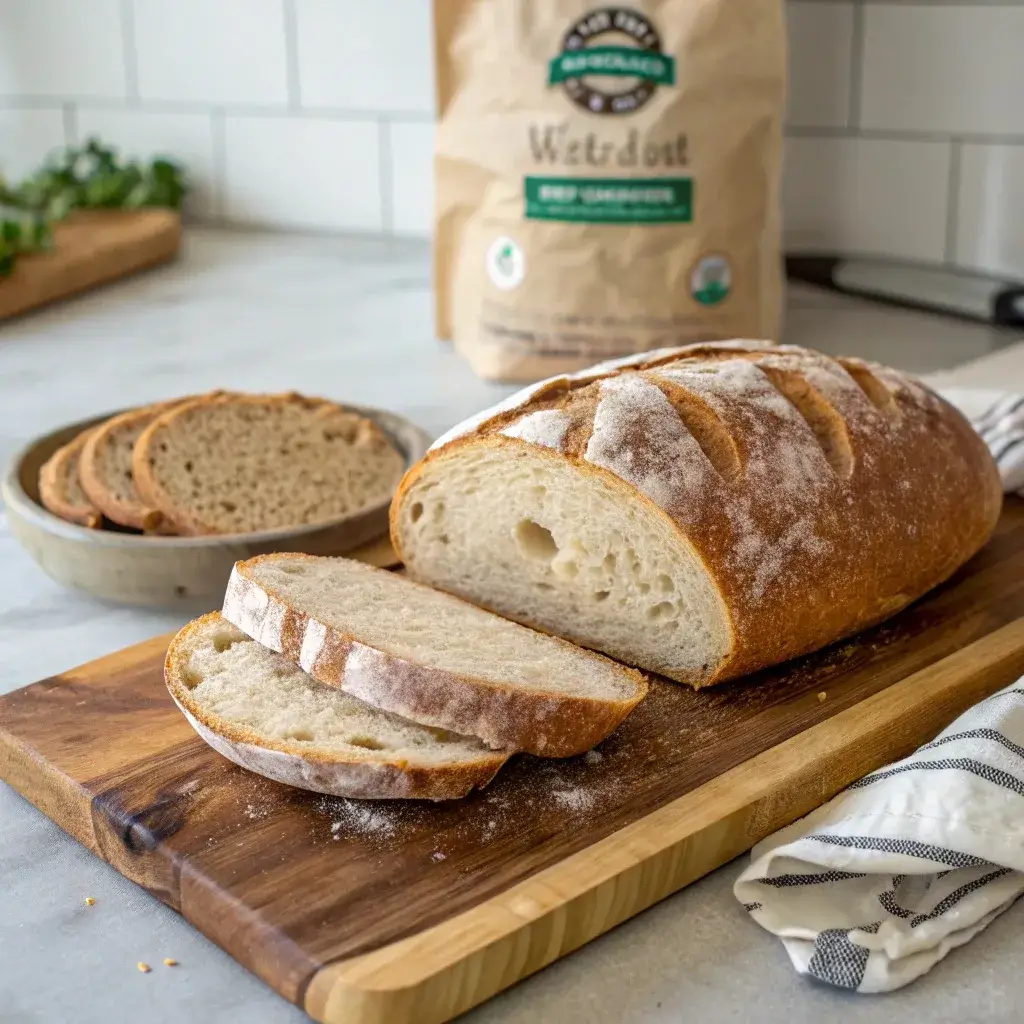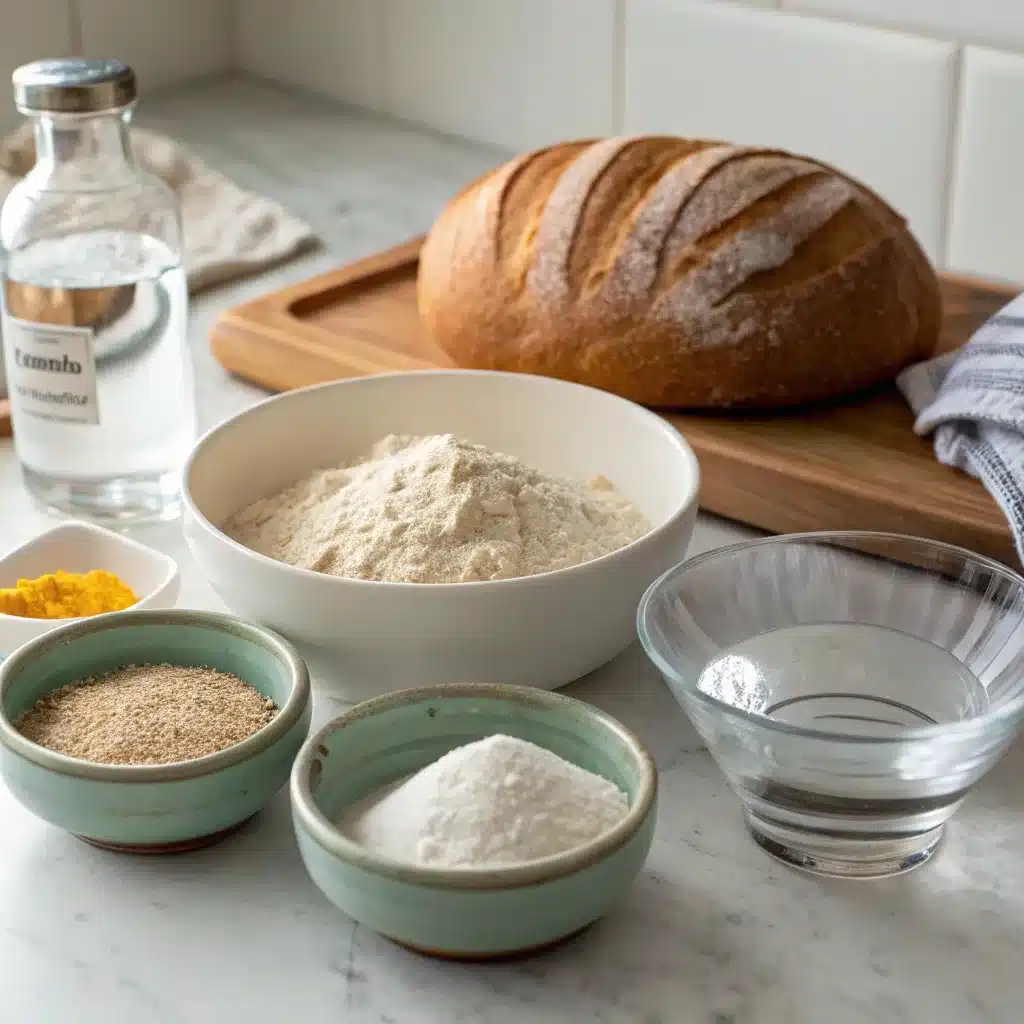If you’re someone who lingers in the bakery aisle at Whole Foods, nose tilted toward that intoxicating tang of sourdough, you’re not alone. In this guide, we’ll explore what sets Whole Foods sourdough bread apart—from its ingredients and nutritional value to where it stacks up against other supermarket loaves. You’ll also discover how to store it, spot the real deal, and even toast it to perfection. Let’s dive in.
Table of Contents

The Story & Intro: A Love Letter to Sourdough at Whole Foods
Memorable Beginnings with Whole Foods Sourdough Bread
My sourdough story started on a regular Tuesday, with twin boys cranky after soccer practice and no dinner in sight. I grabbed a loaf of Whole Foods sourdough bread, still warm from the in-store bakery. As I sliced into the crackly crust, I had no idea it would become a staple in our kitchen. That night, I turned it into gooey grilled cheese with tomato soup—and for once, not a single complaint. It wasn’t just food, it was comfort.
Ever since then, Whole Foods sourdough bread has been my go-to. Its chewy crumb, natural tang, and clean ingredients spoke to the kind of home-cooked, heart-led meals I love to share. Whether I’m building a hearty turkey sandwich or dipping a crusty wedge into olive oil and herbs, this bread always delivers.
For those who love bold West Coast flavor, the San Francisco sourdough bread Whole Foods occasionally stocks delivers that iconic tangy finish—crusty, chewy, and deeply satisfying.
Why Whole Foods Sourdough Bread Wins Fans
What makes Whole Foods sourdough bread so appealing? For one, it’s traditionally made with just flour, water, salt, and naturally occurring wild yeast—no added sugars or preservatives. That means real fermentation, which not only improves digestibility but also brings that classic sour flavor to life.
Many Whole Foods locations bake sourdough fresh in-house daily or stock loaves from regional artisan bakeries. Some even offer organic options or specialty blends like sprouted or multigrain sourdough, as seen in this multigrain sourdough bread variant.
Connecting Flavor with Function
Whole Foods sourdough isn’t just about taste—it’s packed with benefits. The long fermentation process breaks down gluten and phytic acid, making it easier on digestion and better for nutrient absorption. Pair it with a bowl of homemade soup or use it as a base for avocado toast, and suddenly a simple meal feels intentional and elevated.
Looking for lower-calorie options? Check out this deep dive on calories in sourdough bread for nutritional insights that’ll help you make informed choices while still indulging in your favorite loaf.
Whole Foods Sourdough Bread: A Fresh Take on Store-Bought Flavor
There’s something deeply comforting about a warm slice of sourdough, especially when it comes from a brand like Whole Foods. In this article, we’re diving into the world of whole foods sourdough bread, exploring what makes it special, whether it stacks up to bakery loaves, and how it compares with other popular options. We’ll also touch on nutritional value, ingredients, and how to use it creatively in your kitchen. If you’ve ever asked yourself, “Is store-bought sourdough worth it?”—this guide is for you.
The Real Taste of Whole Foods Sourdough Bread
A nostalgic start to my sourdough journey
Back when my twins were still in high chairs, mornings were wild. I’d scramble to make toast while negotiating over which cartoon to watch. One day, I grabbed a loaf of Whole Foods sourdough bread on a whim—desperate for something hearty yet kid-friendly. I toasted it, slathered it with a little almond butter, and watched those picky eaters devour every bite. That was my lightbulb moment. It wasn’t just the flavor; it was the texture, that tangy chew with a crisp crust.
Years later, I still keep a loaf in the pantry for those “what’s for dinner?” days. Whether I’m making fancy avocado toast or a quick grilled cheese, the whole foods sourdough bread always shows up. It’s dependable but still a little luxurious—like the cashmere of grocery-store bread.
On my blog, I’ve shared other ways I elevate simple loaves—like my blueberry sourdough variation for a sweet twist or the frozen sourdough bread tips that save prep time. I’ve learned that sourdough doesn’t need to be fussy. It just needs to be real.
How Whole Foods sourdough stands out
The difference starts with ingredients. Whole Foods’ sourdough options tend to stick to the basics: organic wheat flour, filtered water, salt, and wild yeast. That’s it. No hidden sugars or dough conditioners. Unlike many supermarket breads that just mimic sourdough’s tang using vinegar, this one uses actual fermentation, making it closer to artisan bread.
And yes, Whole Foods does bake some sourdough loaves fresh in-store—just check for that golden crust and airy interior. The organic sourdough bread Whole Foods offers is a standout, especially if you value simple, whole ingredient , especially if you value simple, whole ingredients. There’s also a low-calorie option that keeps the flavor without the guilt.
Pair it with soups, toast it with herbed butter, or just enjoy it plain—because when the bread’s this good, less is more.

Whole Foods Sourdough Bread
Ingredients
Equipment
Method
- Slice sourdough bread to desired thickness. Use a serrated bread knife for best results.
- Toast or grill slices for enhanced texture. Optional: brush with olive oil or butter.
- Use fresh slices for sandwiches, avocado toast, or soup dunking.
- Store leftover slices in a bread bag or freeze for later use. Toast from frozen or thaw overnight.
Nutrition
Notes
Tried this recipe?
Let us know how it was!Comparing Supermarket Options for Sourdough Bread
Whole Foods vs. Other Grocery Store Sourdoughs
Walk into any major grocery store today—Trader Joe’s, Sprouts, Kroger, Safeway—and you’ll likely see loaves labeled sourdough. But here’s the catch: not all of them are real sourdough. Many use shortcuts like commercial yeast and vinegar to mimic that signature tang. Whole Foods sourdough bread tends to go the traditional route, making it a better choice for flavor and digestibility.
Take Trader Joe’s, for example. While their sourdough is decent, there have been rumors about its discontinuation, making Whole Foods a more reliable option. Sprouts offers some artisanal-looking loaves, but many still contain additives or preservatives. In contrast, the Whole Foods bakery often sells true sourdough—and it’s usually labeled with the fermentation process and ingredient transparency.
The multigrain sourdough bread from Whole Foods offers additional fiber and nutrients, unlike basic white sourdoughs found elsewhere. And if you’re gluten-sensitive, their gluten-free whole grain bread is a thoughtful alternative that still offers that satisfying bite.
Why authenticity matters in sourdough
Sourdough is more than a trend. When made traditionally, it’s fermented over hours—or days—using wild yeast. That process creates beneficial bacteria that help break down gluten and unlock nutrients. It’s also what gives sourdough its deliciously chewy interior and crisp crust.
Many store-bought loaves labeled “sourdough” skip the fermentation. Whole Foods sourdough bread, especially their fresh-baked varieties, usually stays true to the method. The result? Better taste, better digestion, and a more satisfying experience overall.
Not to mention, their protein sourdough bread offers a nutritious edge for people looking to add more fuel to their day. If you’re someone who eats bread daily but wants it to work for you nutritionally, that’s worth considering.
So, if you’re standing in the bread aisle wondering which one to toss in your cart, Whole Foods may not be the cheapest, but it’s often the most honest.
For more fun variations and ideas, check out our Facebook and Pinterset sections where creativity meets craving.
Nutrition & Ingredients Deep Dive
What’s inside Whole Foods sourdough bread?
When it comes to clean eating, ingredients matter. That’s where Whole Foods sourdough bread shines. Most of their sourdough varieties include just a few key elements: organic unbleached wheat flour, water, sea salt, and a natural starter. No preservatives. No added sugar. No artificial enhancers.
That simplicity isn’t just marketing. It reflects the traditional method of sourdough baking, which relies on time rather than shortcuts. Because the dough is fermented slowly, it develops its tangy flavor naturally—and becomes easier to digest. This process also helps reduce phytic acid, which can block nutrient absorption in other breads.
If you’re looking to track your intake more closely, check out this quick nutrition breakdown:
| Nutrient | Per Slice (Average) |
|---|---|
| Calories | 90–110 kcal |
| Carbohydrates | 18–20 g |
| Protein | 3–5 g |
| Fat | 0.5–1.5 g |
| Fiber | 1–3 g |
If you’re managing calories or carbs, Whole Foods also offers a low-calorie sourdough that doesn’t sacrifice flavor or texture.
Sourdough benefits you might not know
Beyond taste, sourdough brings health perks. Thanks to its fermentation process, it may have a lower glycemic index than traditional white or wheat bread. That means slower blood sugar spikes—a win for energy levels and mood.
Plus, sourdough’s wild yeast creates lactic acid, which acts as a natural preservative. This helps the bread last longer without any chemical additives. For those with mild gluten sensitivity, some find that real sourdough is easier to tolerate because much of the gluten is broken down during fermentation.

Need more convenience in your routine? Try their frozen sourdough bread, which makes stocking up stress-free without losing that crusty, artisanal finish after reheating.
With Whole Foods sourdough bread, you’re getting more than just bread—you’re getting nutrient density, clean labels, and old-world technique in a modern package.
How to Use Whole Foods Sourdough Bread Creatively
From toast to tartines—meal ideas worth repeating
Sourdough is more than just a base for butter. With its chewy crumb and tangy bite, Whole Foods sourdough bread elevates everything it touches. I’ve used it for open-faced tartines loaded with roasted veggies, as the hero in hearty grilled cheese sandwiches, and even for savory bread puddings when leftovers pile up. The gluten-free sourdough guide on my site has been a lifesaver for friends with dietary restrictions, proving that flavor doesn’t need compromise.
One of my favorite hacks? Turning slices into rustic croutons. Just cube, drizzle with olive oil, and toast in the oven with garlic and herbs. They store well and add a bold crunch to salads and soups. If you want to take things sweeter, use thick slices for French toast—Whole Foods’ sourdough holds up beautifully without going soggy.
For something indulgent, try a sourdough breakfast sandwich with smashed avocado, fried egg, and a sprinkle of chili flakes. Or go sweet with ricotta, honey, and fresh berries on a toasted slice. You’ll find endless inspiration in its versatility.
When leftovers turn into magic
Don’t toss that heel or slightly stale slice. Sourdough ages gracefully, making it ideal for breadcrumbs, croutons, or strata. In fact, slightly dry sourdough absorbs more flavor—perfect for casseroles and stuffing.
I’ve even made a killer sourdough French loaf version with leftover slices, layered with caramelized onions, cheese, and broth for a savory twist on bread pudding.
Another easy idea? Blitz dried slices into breadcrumbs and store them in a jar. Add herbs and Parmesan for an instant topping over pasta bakes or roasted veggies. You can also freeze slices to preserve freshness, as I do with my frozen sourdough prep method. It makes weeknight meals quicker and more delicious.
In my kitchen, nothing goes to waste. And Whole Foods sourdough is the kind of ingredient that keeps giving—even when it’s a day (or three) old.
FAQ: Whole Foods Sourdough Bread
Which is the best supermarket sourdough bread?
The best supermarket sourdough bread often comes down to ingredients and authenticity. Whole Foods sourdough bread consistently ranks high because it uses traditional fermentation and organic, minimal ingredients. Their organic version stands out for both taste and texture, especially when compared to more commercialized options.
Does Whole Foods make fresh sourdough bread?
Yes, many Whole Foods locations bake sourdough bread fresh in-store. Look for loaves with a dark golden crust and airy interior—signs of natural fermentation. The freshness varies by store, so check your local bakery section for “baked today” labels or ask a staff member for details.
Is Trader Joe’s discontinuing sourdough bread?
While there have been online discussions about availability issues, Trader Joe’s has not officially discontinued their sourdough bread. That said, their version often uses commercial yeast and may lack the traditional fermentation found in Whole Foods’ loaves. For those seeking authenticity, Whole Foods remains a more consistent and reliable source.
Which sourdough bread is the healthiest?
The healthiest sourdough bread combines clean ingredients, whole grains, and traditional fermentation. Whole Foods offers several healthy options, including their low-calorie sourdough and protein-enriched sourdough, Whole Foods organic sourdough bread, both of which skip additives and preservatives.
Conclusion
Whole Foods sourdough bread bridges the gap between artisan quality and everyday convenience. With its authentic ingredients, traditional fermentation, and versatile flavor, it’s a grocery store staple that truly delivers. Whether you’re looking for something to complement a healthy lifestyle or need a loaf that works for every meal, Whole Foods makes it easy to eat well without sacrificing taste. From avocado toast to savory bakes, this sourdough earns its place in every home kitchen—especially mine.
